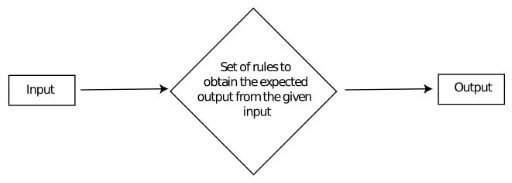Last updated on July 13th, 2024 at 11:03 am
We’ll discuss algorithms, types of algorithms, characteristics and properties of algorithms, why algorithms matter, how to solve a problem, the application of algorithms, and FAQs.
Table of Contents
1. What is an Algorithm?
An algorithm is a finite set of instructions designed to solve particular problems. They provide a systematic way to solve problems more efficiently.
Algorithms are used in various fields such as mathematics, engineering, data analysis, and artificial intelligence.

1.2 Example Code for Algorithm
Algorithm LargestNumber
Input: A list of numbers L.
Output: The largest number in the list L.
if L.size = 0 return null
largest ← L[0]
for each item in L, do
if item > largest, then
largest ← item
return largest
1. "←" denotes assignment. For example, "largest ← item" means that the value of largest changes to the value of item.
2. "return" terminates the algorithm and outputs the following value.
Selecting good algorithms for performing a particular task is like using right and efficient tools in workshop.
Example : Using wrong algorithms is like cutting tree with blade and cutting paper with axe.
1.3 Types of Algorithms
Algorithms can be divided into many types based on their characteristics and functionality.
- Brute Force Algorithms: Solve the problems by exploring all possible solutions for particular problems. However, it is inefficient for solving large problem sizes.
- Divide and Conquer Algorithms: Break the larger problems into smaller subproblems and solve them, then combine their solution to solve the original problems.
- Search Algorithms: Searching a particular item from a group of items. Examples include Linear Search, Binary Search, etc.
- Sorting Algorithms: Arrange a group of items into a specific order (required order sequence). Examples include Bubble sort, Merge sort, Quick sort, Heap sort, etc.
- Graph Algorithms: Solve problems by using graphs including edge and vertex. Such as finding the shortest path, detecting cycles, or finding minimum spanning trees.
- String Matching Algorithms: Searching for occurrences/times of a substring within a larger string. Examples include brute force, Knuth-Morris-Pratt, and Boyer-Moore algorithms.
2. Characteristics of Algorithm
- Preciseness: well-defined steps that can be executed without ambiguity.
- Finiteness: Must be terminated after a finite number of steps.
- Input: Take zero or more inputs, on which algorithm is operating.
- Output: Produce zero or more outputs, that are the solution of a problem.
- Efficiency: Evaluated based on efficiency in terms of time and space complexity, means to get desired results with minimal resources.
3. Properties of Algorithm
There are certain properties algorithms are:
- An Algorithm has zero or more inputs.
- It should produce at least one output.
- It should terminate within a finite time.
- It should be deterministic (ambiguous).
- It is generic to all programming languages.
4. Why Algorithm Matter
- Efficiency: Algorithms solve simple to complex problems more efficiently.
- Automation: Algorithms automate processes which help to complete any task faster and more efficiently.
- Human limitations: Algorithms handle tasks beyond human capacities, like Voice Recognition.
Algorithms can be simple to highly complex, depending on the problems. It enables computers to perform tasks ranging from simple calculations to machine learning or artificial intelligence models.
5. Steps to Solve a Problem
- Define the problem, which means what is the input and what should be the output.
- Identify the constraints that are to be satisfied.
- Design the algorithm for a given problem.
- Draw the flowchart.
- Verify the process.
- Implement the coding.
- Perform time and space analysis.
6. Applications of Algorithms
- Computer science: Basis for programming, sorting, searching, AI, and ML.
- Mathematics: Solving mathematical problems.
- Operations research: Optimizing logistics, transportation, and resource allocation costs.
- Artificial intelligence: Foundation for intelligent systems.
- Data science: Extract, analyze, and create insights from raw data.
FAQs
Can anyone learn algorithms?
Yes, anyone can learn algorithms. Learning any skill requires practice, patience, and understanding. With time and effort, anyone can grasp the concepts and become an expert in algorithms.
How can algorithms be optimized for speed?
Algorithms can be optimized by using an efficient data structure, minimizing redundant computations and memory usage.
What are algorithms used for in everyday life?
Algorithms are used in everyday life for search engines, social media platforms, navigation apps, e-commerce sites, and smart devices.
Are algorithms the same as programming?
Algorithms provide the logic to solve specific tasks or problems while programming translates that logic into executable code to solve the problem.
What are common algorithms used in programming?
Common algorithms include Sorting algorithms like quicksort, and mergesort, Search algorithms like binary search, graph algorithms like Dijkstra’s algorithm, dynamic programming algorithms, and String algorithms like substring search.
How do algorithms impact machine learning?
Algorithms are the backbone of machine learning, determining how models learn patterns from data and make predictions. Algorithms like Neural Networks, Decision Trees, etc.
What is the difference between dynamic programming and greedy algorithms?
Dynamic programming breaks down problems into smaller subproblems, solving them and storing the solutions, for optimizing global solutions.
Greedy algorithms make locally optimal choices at each step with the hope of finding a global optimum, without backtracking.
What is the role of algorithms in artificial intelligence?
Algorithms are the tools that make AI systems smart and capable of solving problems. It helps machines understand the data, learn from it, and make decisions.